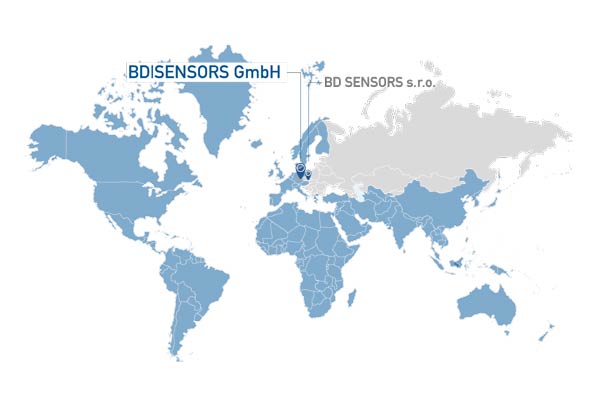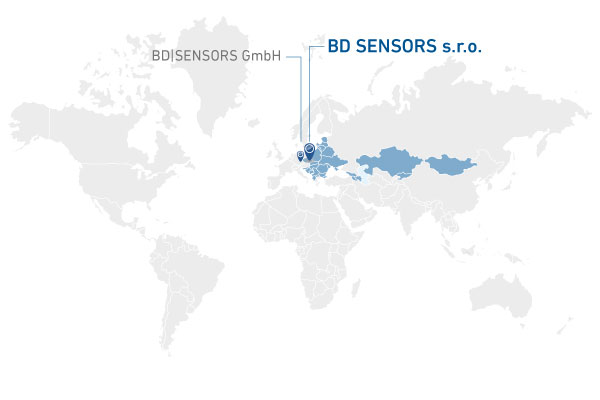Thierstein - As it does every year, Hannover Messe 2017 will offer a great opportunity to learn more about the different methods of electronic pressure and level measurement, the current state of the art and the latest trends. At the exhibition stand of BD|SENSORS GmbH (see text in box), for example, the product range starts with pressure transmitters, differential pressure transmitters, digital manometers and pressure switches for use in different media. It is expanded to include level and submersible probes, data loggers as well as display devices and evaluation instruments. Piezoelectric pressure sensors for highly dynamic measurements complete the range. As the measurement technology specialist from Thierstein sees itself primarily as a provider of solutions, Stand C51 in Hall 11 is also a good port of call for application-specific assignments that cannot be implemented with standard solutions.
Digital manometer with added value
Digital manometers like the DM 01 (image 1) are now widespread in testing, monitoring and calibration applications, and in quality assurance. The battery-operated precision manometer, which has already proved its worth in numerous applications, has been further improved. For example, the integrated data logger can now record up to 600,000 pressure and temperature values in linear and cyclic form, and these values are then processed further using the BD|LOG software. This means that the storage capacity has increased tenfold compared to the previous model, which enables documentation over a longer period or with a higher resolution. Thanks to an integrated bootloader function, users can now update the device software locally; they no longer have to send the device to the manufacturer for an update. Moreover, the digital manometer has become much faster. The CPU and software have been optimised so that instead of 1 to 2 measurements per second, as was previously the case, up to 50 measurements per second are now possible. As the digital manometer has a modular structure and consists of two devices, the digital display and the pressure transmitter, it is easy to fit and can be adapted flexibly to the application. The pressure transmitter can be selected on site for different measurement ranges and be connected to the display easily and without any tools or calibration.
PRODUCT RELEASE AT HANOVER TRADE FAIR
More about digital gauge DM 01 (current version)
DM 01 - Smartphone app makes it easy to read
The highlights to be presented at Hannover Messe 2017 in the area of electronic pressure measurement technology will also include the new digital manometer DBT 10 (image 2); examples of preferred areas of application are pressure monitoring on tanks in environmental technology or plant and mechanical engineering. Thanks to the Bluetooth Smart Ready interface and smartphone app, the values displayed can now also be read easily even in unfavourable installation situations. To do this, the user can simply connect to the device and does not need to be able to see the display directly. The app for Android and iOS will shortly be available to download.
Piezoelectric sensors for highly dynamic pressure measurements
Piezoelectric sensors from the DAC range (image 3) are ideal for pressure measurements in extreme situations – such as pressure spikes or pressure surges, pressure gradients during explosions or combustions (e.g. in the case of ballistic measurements or the ignition of internal combustion engines). They are suitable for dynamic measurements up to a range of over 100 kHz, cover pressure ranges of up to 8,000 bar and with 100 Pa also offer high resolution even with a large base load and low pressure fluctuations. As they are very small, they can easily be integrated into the applications. The pressure sensors are based on monocrystals of gallium phosphate (GaPO4) which are highly sensitive and reliable at the same time. Good signal characteristics, low temperature drift and high resistance to temperatures of up to +400°C (special series up to +700°C) are further characteristics that are persuasive in practice.
More about piezoelectric pressure sensors
Submersible probes for hydrostatic level measurements
For hydrostatic level measurement for all kinds of liquid and pasty media, the measurement technology specialist presents a wide variety of different submersible and screw-in probes (image 4) which are suitable, for example, for use in water, waste water and for tank management systems in the chemical and shipbuilding industries. Different sensor technologies (stainless steel and extremely resistant ceramic) offer a “customised” solution for all applications that is also able to withstand pressure surges and abrasive or chemically aggressive media.
Detachable submersible probes in which the cable part can easily be detaches from the probe without any additional tools are particularly practical. Assembly, maintenance, servicing and storage are greatly simplified as a result. The standard range also includes submersible probe versions for example with integrated surge protection, with a temperature sensor or data logger as well as versions that are capable of communication with an RS-485 interface or HART protocol.
LMK 808 - Detachable plastic submersible probe with ceramic sensor – durable and accurate
Submersible probes which are used to monitor river levels or to control lock gates frequently suffer from algae and mussel growth. In the case of submersible probes with a stainless steel sensor, the cleaning and removal of the mussels can result in the sensitive diaphragm being damaged or destroyed. The new submersible probe LMK 808 (image 5) is equipped with a robust capacitive ceramic sensor. Hardly anything sticks to the high-purity ceramic diaphragm made of 99.9% Al2O3 and, if it does, it is easy to clean without damaging the diaphragm. It is resistant to corrosion by water and aggressive media such as acids and alkaline solutions. In addition, the submersible probe offers high accuracy of up to 0.25% FSO and has outstanding long-term stability. The measurement data from the submersible probes is often transmitted to a controller over cables which are laid in the ground or in ducts and often extend over several hundred metres. If rodents damage these cables, the work required to replace them is complex and expensive. This is no longer a worry with the new submersible probe because a steel mesh cable sheath offers reliable protection from rodent bites. To largely avoid damage caused by lightning, improved surge protection has been integrated in the probe head, allowing pulse currents of up to 8 kA to be dissipated. If there is a defect following a very severe lightning strike, only the probe head needs to be replaced; the cable suffers no damage.
![[Translate to englisch:] [Translate to englisch:]](/fileadmin/user_upload/Aktuelles/2017/News_2017_Druckmesstechnik-HMI.jpg)


